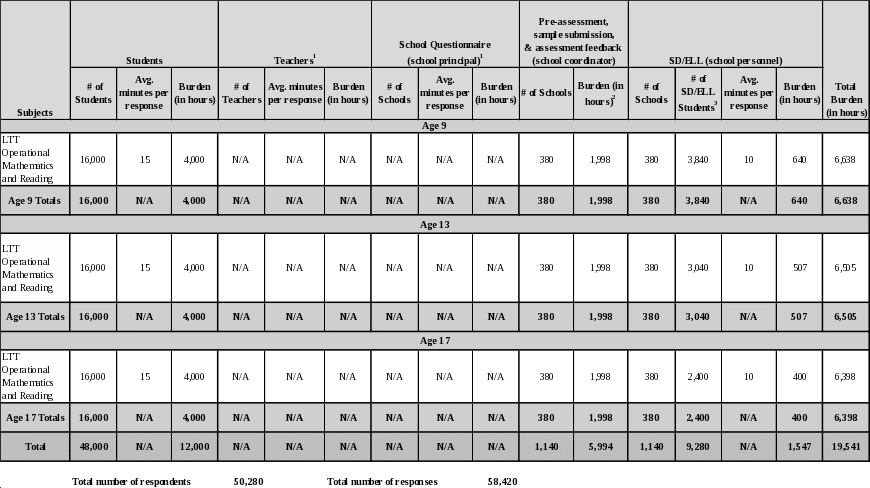Change sheet memo
NAEP 2019 and 2020 LTT MSTS Cancellation Change Request Memo.docx
National Assessment of Educational Progress (NAEP) 2019 and 2020 Long-Term Trend (LTT) Update 2
Change sheet memo
OMB: 1850-0928
U NITED
STATES DEPARTMENT OF EDUCATION
NITED
STATES DEPARTMENT OF EDUCATION
National Center for Education Statistics
January 31, 2020
MEMORANDUM
To: Robert Sivinski, OMB
From: Linda Hamilton, NCES
Through: Kashka Kubzdela, NCES
Re: National Assessment of Educational Progress (NAEP) 2019 and 2020 Long-Term Trend (LTT) 2019 Middle School Transcript Study (MSTS) Cancellation Change Request (OMB# 1850-0928 v.19)
The National Assessment of Educational Progress (NAEP), conducted by the National Center for Education Statistics (NCES), is a federally authorized survey of student achievement at grades 4, 8, and 12 in various subject areas, such as mathematics, reading, writing, science, U.S. history, civics, geography, economics, technology and engineering literacy (TEL), and the arts. The National Assessment of Educational Progress Authorization Act (Public Law 107-279 Title III, section 303) requires the assessment to collect data on specified student groups and characteristics, including information organized by race/ethnicity, gender, socio-economic status, disability, and limited English proficiency. It requires fair and accurate presentation of achievement data and permits the collection of background, noncognitive, or descriptive information that is related to academic achievement and aids in fair reporting of results. The intent of the law is to provide representative sample data on student achievement for the nation, the states, and subpopulations of students and to monitor progress over time. The nature of NAEP is that burden alternates from a relatively low burden in national-level administration years to a substantial burden increase in state-level administration years when the sample has to allow for estimates for individual states and some of the large urban districts.
The request to conduct NAEP 2019 and 2020 was approved in September 2018 with the latest update to the NAEP 2020 plan, consisting of the finalization of the Long Term Trend (LTT) assessment to be conducted during the 2019-20 school year, approved in August 2019 (OMB# 1850-0928 v.10-17). The LTT assessments are based on nationally representative samples of 9-, 13-, and 17-year old students, and have been used by NAEP since the early 1970s to provide measures of students’ educational progress over long time periods to allow for analyses of national trends in students’ performance in mathematics and reading. NAEP 2019 data collection has been concluded.
This request notifies OMB of changes needed to the approved package (OMB# 1850-0928 v.11-17). While we originally planned to conduct the MSTS activities after the 2019 NAEP administration, due to budgetary constraints for the NAEP program, NCES concluded that the MSTS would not be conducted.
Due to this change, no middle school incurred any burden associated with participating in the 2019 MSTS, which changes the estimated burden calculation as follows.
EXHIBIT 1
Estimated Burden for NAEP 2019–2020 Assessments
(Note: all explanatory notes and footnotes are displayed following the 2020 table)
2019


2020

Notes for 2019 table in Exhibit 1
The burden for the school coordinator is as follows: Pre-assessment burden is 4.5 hours, sample submission burden is 2 hours (for 26% of schools in 2019 based on 2017 data), school coordinator wrap-up activities is 7 minutes and post-assessment follow-up survey is 10 minutes (for 25% of the schools).
The estimated percent of SD/ELL students (based on the NAEP 2017 sample) is 24%, 19%, and 15%, at grades 4, 8, and 12, respectively.
Grade 8 teachers who teach one subject have an estimated burden of 20 minutes, with an additional 10 minutes for each additional subject. The estimated number of teachers who teach 1 subject is 50%, 2 subjects is 45%, 3 subjects is 4%, and 4 subjects is 1%.
The PBA are administered in the same schools as the DBA. As such, there are not additional teacher or school questionnaires associated with the PBA. In addition, the same school personnel will provide the SD and ELL information for the DBA and PBA students and this does not add to the total number of respondents.
The burden for NIES is associated with the additional questionnaire that is given to the same students, teachers, and school administrators that respond to the main NAEP questionnaires. As such, the NIES questionnaire does not impact the total number of respondents. The estimated number of students, teachers, and school administrators that will respond to the NIES questionnaires is based on the 2015 sample.
The burden for CAFS is associated with the additional questionnaire that is given to the same students and teachers that respond to the main NAEP questionnaires. As such, the CAFS questionnaire does not impact the total number of respondents. The CAFS questionnaires are administered to all science students and their science teachers in 25% of the schools in the science sample.
The burden for SES-SQ is associated with the additional questionnaire that is given to the same students that respond to the main NAEP questionnaires. As such, the SES-SQ questionnaire does not impact the total number of respondents. The SES-SQ questionnaires are administered to all pilot students in 50% of the schools in the pilot sample.
The burden for MSTS is 12 hours for district personnel to participate in the interviews, gather the information, upload the course catalogue, and upload student transcripts.The burden for HSTS is as follows: school personnel in all 12th grade schools will submit the school information form and additional information (1 hour); state or district personnel will submit the course catalog and student transcripts electronically (10 hours for 30% of the schools which come from 40% of the states and all TUDAs); school personnel in 10% of the schools will submit the course catalog and student transcript electronically (2.5 hours); and school personnel in 60% of the schools will support NAEP field staff collection of paper student transcripts (2 hours).
Notes for 2020 table in Exhibit 1
There are no survey questionnaires for teachers or schools.
The burden for the school coordinator is as follows: Pre-assessment burden is 4.5 hours, sample submission burden is 2 hours (for 30% of schools in 2020, based on 2018 data, respectively), school coordinator wrap-up activities is 7 minutes and post-assessment follow-up survey is 10 minutes (for 25% of the schools).
The estimated percent of SD/ELL students is 24%, 19%, and 15%, at ages 9, 13, and 17, respectively.
EXHIBIT 2
Total Annual Estimated Burden Time Cost for NAEP 2019–2020 Assessments
Data Collection Year |
Number of Respondents |
Number of Responses |
Total Burden (in hours) |
2019 |
997,086 |
1,225,727 |
625,665 |
2020 |
50,280 |
58,420 |
19,541 |
2-year Sum Total |
1,047,366 |
1,284,147 |
645,206 |
2-year Annual Average |
523,683 |
642,074 |
322,603 |
The
estimated respondent burden across all these activities translates
into an estimated total burden time cost of $9,639,654
$9,629,435 for 645,530 645,206
hours1,
broken out by year and respondent group in the table below.
|
Students |
Teachers and School Staff |
Principals |
Total |
||||
|
Hours |
Cost |
Hours |
Cost |
Hours |
Cost |
Hours |
Cost |
2019 |
435,672 |
$3,158,622 |
177,259 |
$5,594,797 |
12,734 |
$613,553 |
625,665 |
$9,366,972 |
2020 |
12,000 |
$87,000 |
7,541 |
175,463 |
0 |
0 |
19,541 |
262,463 |
Total |
447,672 |
$3,245,622 |
184,800 |
$5,770,260 |
12,734 |
$613,553 |
645,206 |
$9,629,435 |
1 This is based on 447,672 hours for students at $7.25 an hour (based on the federal minimum wage), 181,698 hours for teachers and school staff at $31.54 an hour (based on a 10-month salary from data from Bureau of Labor Statistics, U.S. Department of Labor, The Economics Daily, Employment and annual wages for preschool, primary, middle, and secondary school teachers, on the Internet at http://www.bls.gov/opub/ted/2015/employment-and-annual-wages-for-preschool-primary-middle-and-secondary-school-teachers.htm [visited December 08, 2015]), and 14,371 hours for principals at $48.18 an hour (based on data from Bureau of Labor Statistics, U.S. Department of Labor, Occupational Outlook Handbook, Elementary, Middle, and High School Principals, on the Internet at https://www.bls.gov/ooh/management/elementary-middle-and-high-school-principals.htm [visited March 7, 2018]).
550 12th Street, S.W., Washington, DC 20202
Our mission is to ensure equal access to education and to promote educational excellence throughout the Nation.
| File Type | application/vnd.openxmlformats-officedocument.wordprocessingml.document |
| File Modified | 0000-00-00 |
| File Created | 2021-01-14 |
© 2025 OMB.report | Privacy Policy